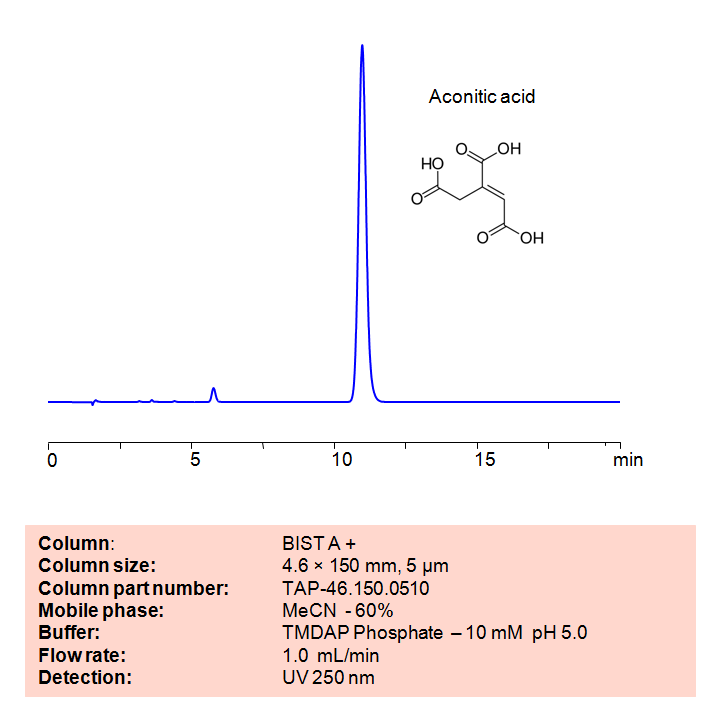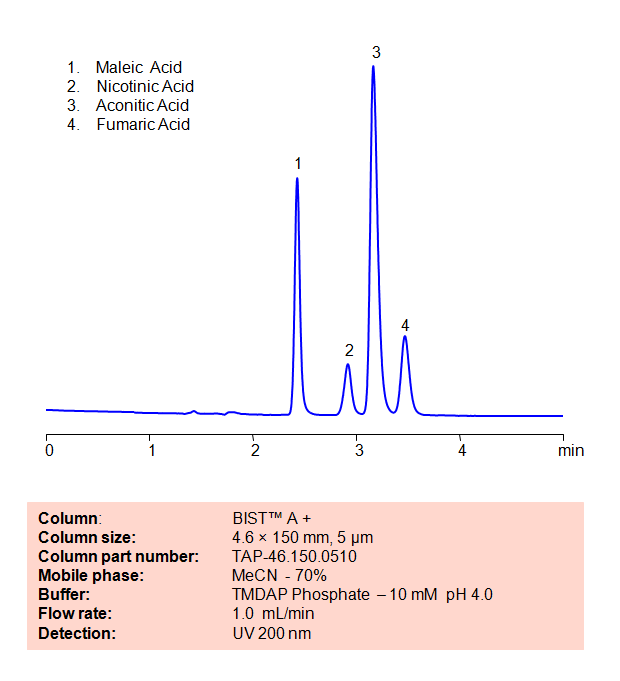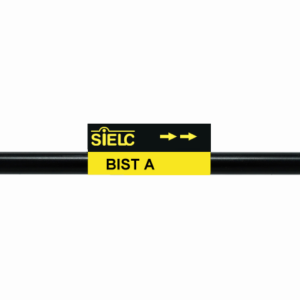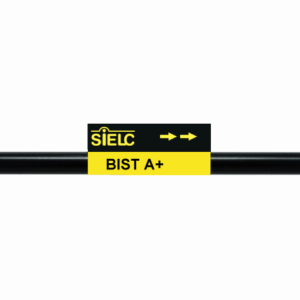| CAS Number | 209-564-4 |
|---|---|
| Molecular Formula | C6H6O6 |
| Molecular Weight | 174.11 |
| InChI Key | GTZCVFVGUGFEME-IWQZZHSRSA-N |
| LogP | -1 |
| Synonyms |
|
Applications:
HPLC Method for Analysis of Aconitic Acid on BIST A+
November 30, 2022
Separation type: Bridge Ion Separation Technology, or BIST™ by SIELC Technologies
HPLC Method for Analysis of Aconitic Acid on BIST A Column by SIELC Technologies

High Performance Liquid Chromatography (HPLC) Method for Analysis of Aconitic Acid
Aconitic acid is a popular compound used to artificial create nutty flavors in foods. It is also a common intermediate in the Kreb’s cycle when Citrate is changed into D-isocitrate. Using SIELC’s newly introduced BIST™ method, Aconitic acidcan be retained easily on a negatively-charged, cation-exchange BIST™ A column. There are two keys to this retention method: 1) a multi-charged, positive buffer, such as N,N,N’,N’-Tetramethyl-1,3-propanediamine (TMDAP), which acts as a bridge, linking the negatively-charged anion analytes to the negatively-charged column surface and 2) a mobile phase consisting mostly of organic solvent (such as MeCN) to minimize the formation of a solvation layer around the charged analytes. Other positively-charged buffers that can generate BIST™ include DMP, Calcium acetate, and Magnesium acetate. Using this new and unique analysis method, Aconitic acid can be retained with high selectivity and great peak shape. This method can be detected and is compatible with ELSD, CAD, and Mass Spectrometry (LC-MS).
Condition
| Column | BIST™ A+, 2.1×100 mm, 5 µm, 100A |
| Mobile Phase | MeCN – 50/50% |
| Buffer | TMDAP formate pH 5.0 – 5,0 mM |
| Flow Rate | 0.5 ml/min |
| Detection | MS, ESI-, m/z = 173 |
Description
| Class of Compounds | Acid, Carboxylic acids, Tricarboxylic acids |
| Analyzing Compounds | Aconitic Acid |
Application Column
BIST A
BIST™ columns offer a unique and effective way to achieve separations that were traditionally challenging or even impossible with other HPLC columns. With the use of a special mobile phase, these ion exchange columns provide very strong retention for analytes with the same charge polarity as the stationary phase, unlocking new chromatography applications. What makes BIST™ columns stand out is their proprietary surface chemistry, which results in superior selectivity, resolution, and sensitivity. These columns offer a simple, efficient solution for a variety of analytical challenges, making them an excellent choice for researchers and analysts across many different fields. To learn more about the technology that powers BIST™ columns and to explore related applications, check out https://BIST.LC.
Select optionsBIST A+
BIST™ columns offer a unique and effective way to achieve separations that were traditionally challenging or even impossible with other HPLC columns. With the use of a special mobile phase, these ion exchange columns provide very strong retention for analytes with the same charge polarity as the stationary phase, unlocking new chromatography applications. What makes BIST™ columns stand out is their proprietary surface chemistry, which results in superior selectivity, resolution, and sensitivity. These columns offer a simple, efficient solution for a variety of analytical challenges, making them an excellent choice for researchers and analysts across many different fields. To learn more about the technology that powers BIST™ columns and to explore related applications, check out https://BIST.LC.
Select optionstrans-Aconitic acid

HPLC Method for Analysis of Aconitic Acid on BIST A+ Column
October 15, 2022
HPLC Method for Aconitic acid, trans-Aconitic acid on BIST A+ by SIELC Technologies

Aconitic acid is a popular compound used to artificial with the chemical formula C6H6O6. It is used to create nutty flavors in foods. It is also a common intermediate in the Kreb’s cycle when Citrate is changed into D-isocitrate.
Using SIELC’s newly introduced BIST™ method, [compound] can be retained easily on a negatively-charged, cation-exchange BIST A+ column. There are two keys to this retention method: 1) a multi-charged, positive buffer, such as N,N,N’,N’-Tetramethyl-1,3-propanediamine (TMDAP), which acts as a bridge, linking the negatively-charged anion analytes to the negatively-charged column surface and 2) a mobile phase consisting mostly of organic solvent (such as MeCN) to minimize the formation of a solvation layer around the charged analytes. Other positively-charged buffers that can generate BIST™ include DMP, Calcium acetate, and Magnesium acetate. Using this new and unique analysis method, Aconitic acid can be retained with high selectivity and great peak shape. This method can be detected and is compatible with ELSD, CAD, and Mass Spectrometry (LC-MS).
Condition
| Column | BIST A+, 4.6 x 150 mm, 5 µm, 100 A, dual ended |
| Mobile Phase | MeCN – 60% |
| Buffer | TMDAP Phosphate pH 5.0 – 10 mM |
| Flow Rate | 1.0 ml/min |
| Detection | UV 250 nm |
Description
| Class of Compounds | Acid |
| Analyzing Compounds | Aconitic acid, trans-Aconitic acid |
Application Column
BIST A+
Column Diameter: 4.6 mm
Column Length: 150 mm
Particle Size: 5 µm
Pore Size: 100 A
Column options: dual ended
trans-Aconitic acid

HPLC Method for Analysis of Maleic Acid, Nicotinic Acid, Aconitic Acid and Fumaric Acid on BIST™ A+ Column
July 7, 2022
Separation type: Bridge Ion Separation Technology, or BIST™ by SIELC Technologies

The maleate ion from Maleic acid is a popular ingredient as the maleate salt in several different drugs, including Methergine, Pyrilamine, and Carfenazine, among others. Nicotinic acid, also known as Niacin or Vitamin B3, is an essential nutrient for the human body and is sometimes taken as a treatment for high cholesterol. Aconitic acid is a key intermediary in the citric acid cycle, and is also used a flavoring agent and in the production of rubbers and plastics. Fumaric acid is a popular preservative and food additive with a fruit-like taste. Using SIELC’s newly introduced BIST™ method, a mixture of these organic acids can be separated on a negatively-charged, cation-exchange BIST™ A+ column, contrary to conventional chromatographic wisdom. There are two keys to this retention method: 1) a multi-charged, positive buffer, such as N,N,N’,N’-Tetramethyl-1,3-propanediamine (TMDAP), which acts as a bridge, linking the negatively-charged anion analytes to the negatively-charged column surface and 2) a mobile phase consisting mostly of organic solvent (such as MeCN) to minimize the formation of a solvation layer around the charged analytes.
Condition
| Column | BIST™ A+, 4.6×150 mm, 5 µm, 100A |
| Mobile Phase | MeCN – 70% |
| Buffer | TMDAP ( N,N,N’,N’-Tetramethyl-1,3-diaminopropane) Phosphate – 10 mM pH 4.0 |
| Flow Rate | 1.0 ml/min |
| Detection | UV 200 nm |
Description
| Class of Compounds | Acid, Dicarboxylic acid, Tricarboxylic acid, Pyridinecarboxylic acid |
| Analyzing Compounds | Maleic Acid, Nicotinic Acid, Aconitic Acid, Fumaric Acid |
Application Column
BIST A+
BIST™ columns offer a unique and effective way to achieve separations that were traditionally challenging or even impossible with other HPLC columns. With the use of a special mobile phase, these ion exchange columns provide very strong retention for analytes with the same charge polarity as the stationary phase, unlocking new chromatography applications. What makes BIST™ columns stand out is their proprietary surface chemistry, which results in superior selectivity, resolution, and sensitivity. These columns offer a simple, efficient solution for a variety of analytical challenges, making them an excellent choice for researchers and analysts across many different fields. To learn more about the technology that powers BIST™ columns and to explore related applications, check out https://BIST.LC.
Select optionsFumaric Acid
Maleic Acid
Nicotinic Acid/Niacin (3-pyridinecarboxylic acid)
trans-Aconitic acid




